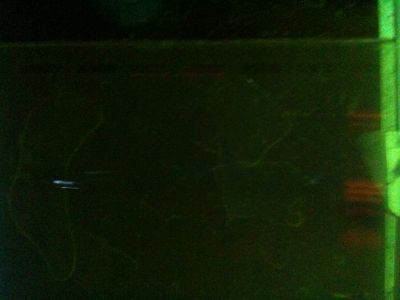Project:Public Biobrick
Overview
UCL's igem team got in touch with us in May about a collaboration with their project to make a biobrick that could help to clean up plastic floating in the ocean. From August the biohackers have been working with them to develop a 'public biobrick' (ie. one developed outside of the traditional university or research lab). This biobrick contains antifreeze and mercuric reductase genes from the marine bacteria Oceanibulbus Indolifex.
Designing primers to amplify the antifreeze and mercuric reductase genes from O. Indolifex
TBA
Generating competent cells (Hackspace)
The competent cells are what will take up and express the biobrick at the end of the process. The procedure we followed is here. We built an incubator with shaker to achieve this. After 24 hours we did not see the expected colonies on the plates, we think this is because the streaks were cut too deeply into the growth medium. As an alternative we proceeded with some already prepared plates from UCL that did have colonies.
Amplification of plasmid backbone (Hackspace)
The plasmid backbone is the vehicle for the biobrick, and is the means by which it will get into the competent cells. The procedure is in the same link as for competent cells. We did two versions of this reaction, one with the mastermix supplied by UCL, and one with the taq readymix that we use at the hackspace. We saw a band for the readymix one, but not for the mastermix one, so proceeded with the readymix one.
DNA extraction from O. Indolifex and PCR of two genes
3-5/9- UCL
In this step we attempted to isolate the two genes to be used in the biobrick. The protocol is [TBA here]. Our PCRs failed, and it turned out that no DNA had been extracted by the Generation Column Capture Kit we used. So we proceeded with a previous extraction that had been done with ethanol.
12-13/9 - Hackspace
PCR of O. Indoliflex antifreeze gene template (provided by UCL) with antifreeze primers including biobrick prefix and suffix.. Positive control was the plasmid backbone we had previously amplified successfully at the hackspace. No bands were visible on the gel, either for the sample or the positive control, indicating PCR failed. Two theories for why this happened:
- We forgot to add oil to the reactions to stop evaporation, running the risk of the reaction mix evaporating. On the other hand not much seemed to have evaporated by the end of PCR.
- We used a PCR program designed for Phusion DNA polymerase and a different type of thermocycler, whereas we used our own thermocycler and our standard taq readymix. The major difference is that we usually have a denaturation step of 30 sec, whereas the UCL protocl calls for a D step of 10s. Other parameters are similar
Procedure:
- ANF template reaction mix: 5ul of template, 2.5ul FP (ANFR1), 2.5ul RP (1RFNA), 25ul of taq readymix, 18ul dH20
- Positive control PSB1C3 (plasmid backbone) reaction mix: 3ul DNA template, 1ul FP, 1ul RP, 25ul of taq readymix, 20ul dH20
Genomic extraction of O. Indoliflex with ethanol.
Both extractions showed up as faint bands in the wells, indicating gDNA extraction succeeded. Bands were same strength as I had previously seen for gDNA extractions at the hackspace, but should have been stronger. This could either be due to the extraction method not extracting enough DNA, or our visualisation technique being inadequate.
Procedure:
- gDNA extraction from the attachment to this email, without the phenol/chloroform steps. Of the options, we froze at -20 overnight, and extended the centrifuge steps by 10 mins each due to our less powerful centrifuge. Resuspended pellet in dH20, then separated this supernatant from remaining debris (this step not necessary in protocol). Procedure had previously worked at UCL.
Lanes from right:
- 1: Ladder. Note that loading dye is in the middle of ladder. Possibly because current turned off for 5 mins during gel run?
- 2: ANF
- 3: Positive control PSB1C3
- 4: O. Indofilex gDNA sample 1 (band just visible)
- 5: O. Indofilex gDNA sample 1 (band just visible)
Restriction digest for ligation (UCL)
TBA
Miniprep: Plasmid DNA Extraction
TBA
